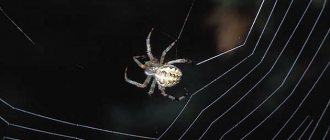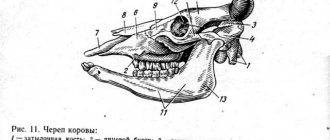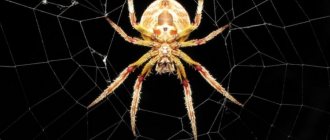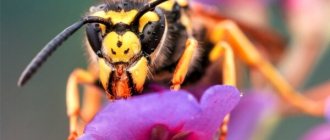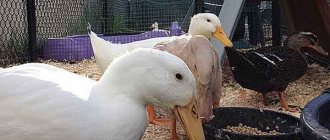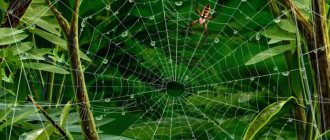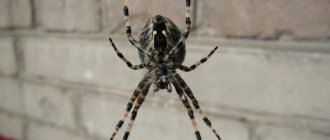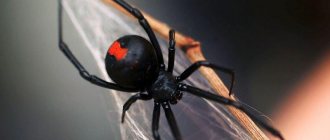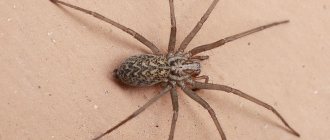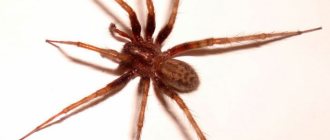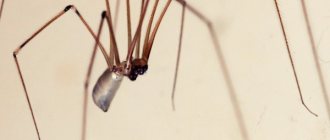Spiders are one of the oldest animals on Earth and can be found almost everywhere in the world today. It is difficult to be indifferent to these creatures: they frighten some, fascinate others.
These are amazing creatures of nature that still hide many mysteries.
Feeding spiders
The spider is considered a predatory creature by nature. Its diet mainly consists of insects, and it can sometimes catch small animals. The exception is the jumping spider; it prefers to eat only plant foods (grass, berries, leaves).
Read also: Why Wi-Fi doesn't work
The arthropod hunts using nets that it skillfully weaves from cobwebs. In nature, there are varieties of these creatures that use web shots during hunting, while they hypnotize the prey, leaving it no chance to escape.
Despite the fact that they are considered obligate predators, catching prey on their own, they do not have teeth . To eat prey, they need to dissolve its tissues and make a nutritious broth from it.
Making a nest
More precisely, it’s not us who make things, but the mother of spiders. These arthropods develop in eggs. The spider keeps it securely in a cocoon.
But first things first. First, the future mother spider weaves a nest. A “backing” is woven under the eggs. It is a soft web. Eggs are laid on this web. And the top is covered with another layer of cobwebs. The result is pancakes made from spider webs with an egg-shaped filling between them.
After the pancake is ready, the spider turns it into a cocoon. And attaches it to the wall of the nest. In it, the eggs mature, and the baby spiders inside are preparing to be born.
Is a spider an insect or not?
Many people wonder whether a spider actually is an insect or an animal. Most will immediately answer that it is an insect, but this is not the case. Even if in appearance this organism looks like crawling small inhabitants, it is in no way related to them and has distinctive features.
They are animals; among the inhabitants of the fauna they are classified as invertebrates. These are arthropods that have jointed limbs, a hard chitinous cover, which is a hard exoskeleton.
Therefore, the question arises why spiders are not insects and animals. And also interested in what exactly connects mammals, what common features they have with insects and differences from them. This is worth considering carefully.
General signs
The family of spiders and insects share some common characteristics. This is due to the fact that arachnids belong to the class of arthropods.
Place in nature
Spiders are a significant and irreplaceable part of the ecosystem. They are of great importance, performing important functions:
- by feeding on a variety of insects, they regulate their numbers;
- They themselves are food for many animals.
Among those who eat spiders are:
- insects (mantises, blackbirds, scolopendras, wasps);
- spiders (representatives of some species feed on their own kind);
- reptiles (snakes, lizards);
- amphibians (toads, frogs);
- small mammals (hedgehogs, rats, mice, noses).
And, of course, birds feed on spiders, for some of which arachnids are their main food.
Interesting facts about spiders
Unusual facts about spiders will amaze many who do not yet know about these creatures. But they conceal many mysteries, secrets, and have unique features that other organisms living on the globe do not have.
Let's look at 15 interesting facts about spiders:
- The web is not only a trap for insects, it is capable of deflecting several millimeters in order to grab and stick an insect to itself. This phenomenon is carried out due to a static charge, which appears during the flight of the insect.
- The bite of the Brazilian wandering spider is not always fatal, but it often causes impotence in men.
- With the help of its limbs, the spider can determine what has reached it in the web. But edible or inedible helps him establish the olfactory organs, which are located on his legs.
- The animal has a durable shell. Its strength can withstand a nuclear explosion.
- The web is very light. If you take a spider thread the length of the earth's equator, then its weight will be only 340 grams.
- Spider web is considered a powerful and durable material. If its thickness is increased to the thickness of a pencil, then such a web could stop a Boeing. In New Guinea, fishermen use this material to catch fish, and in South America there are spider web bridges that support monkeys.
- The lifespan of arthropods is 30 years. But they rarely die of old age.
- At one time, the female can lay up to 20 thousand eggs, from which spiders hatch.
- In nature, there are varieties of spiders that, after being born, eat their mother.
- There are varieties of arachnids in which the brain occupies the largest part of the body, so other organs are forced to be located on the legs. The smaller the spider, the larger its brain.
- In the Netherlands there are more spiders than people. For 15 million human population there are 5 thousand billion arthropods.
- In Cambodia, people enjoy eating tarantula spiders. They are also brought up at home, they learn to dance, and play willingly. And if necessary, they can protect the owner.
- There are types of spiders that do not weave webs - the jumping spider, the lynx spider. They do not catch prey with webs, but hunt it.
- Tarantulas can live without food for about two years.
- The gladiator got its name due to the fact that it weaves a web in a square. He does not leave her until the prey falls into her; he himself abruptly throws the net on her, thereby leaving no chance to escape.
Safe
The word “safe” means that their bite has not yet caused death. However, it can be painful, cause allergic reactions and be accompanied by swelling, since most spiders still contain poison, although not very toxic.
For people suffering from arachnophobia, their appearance is especially dangerous. Thus, the tarantula grows up to 27 cm in length, has an eerie palette and thick hair, but despite this, exotic lovers see it as an excellent pet.
House spider
From the name it is clear that this species lives near people - in gardens, rotten trees, houses, apartments, warehouses and other premises. Its size is 1-2 cm, and its color is different shades of brown. Rarely does anyone manage to see a web, since it is only several times larger than the individual and is located in dark, secluded places.
This representative feeds on insects and, thanks to its powerful paws, often catches them with lightning-fast attacks. For them, a poisonous bite is fatal, but a person will only feel pain for a couple of hours, so it is absolutely safe. There is a sign that the spider settles in the apartment where peace, tranquility and love reign, so it is only scary in appearance.
South Russian tarantula (mizgir)
It lives in deserts, forest-steppe zones and in places where there is little moisture, and lives most of the time in its burrow. Representatives can grow up to 3 cm, and in appearance and structure they are similar to other tarantulas. The diet consists of insects, but if there is a shortage of food, it may include larger targets - frogs, mice, and other spiders.
Mizgir is also considered safe for people and pets, however, its poison does not cause the most pleasant sensations. The bite site may hurt for 1 to 3 days, while it swells and turns yellow for several months. Often the victim's temperature rises and vomits.
Horse
The dimensions of the jumping spider often do not exceed 10 mm. According to the description, this is a small, nimble spider that can be found anywhere. Due to its tiny body, it eats exclusively insects, and avoids humans even if protected, since it is unable to bite through the skin. “Horses” received this nickname due to their powerful jumps of up to 20 cm.
Their limbs have a special structure and can expand or contract simultaneously with the pressure inside the body. The 8 eyes located around their heads help them calculate the trajectory and distance to the target, and jumps are always made with a safety thread. They can be of different colors - white, blue, yellow, black, because the family has about 5,000 species.
Additional Information! There is a flower spider that belongs to the sidewalker family. You can find it in the flower of some plant, and it got its name for its incredible ability to move sideways.
Argiope Brünnich garden
Despite such a complex name, everyone has seen this spider, because it has a specific color on its back and is somewhat reminiscent of a wasp. This representative belongs to the orb weaver breed, so it is often found sitting on a large round web with its limbs arranged in the shape of the letter X.
Argiope's list of enemies includes everything that falls into the web, even the human hand. There have already been similar cases, but since its poison is weak, no deaths have been recorded. The reproduction of these representatives is much more interesting. Immediately after mating, the female eats the male, and she dies as soon as she lays eggs in cocoons. Thus, the offspring obviously remain without parents and develop independently.
Interesting Facts
Spiders inspire fear in people, but at the same time they inspire interest. Therefore, they are studied and even raised at home as pets.
Flying spiders There is evidence that some species of spiders can fly. And this is not to instill fear in the impressionable. This method is a protection and a method of movement.
Spiders with a tail There were individuals that had a tail. Unusual tailed spiders and their descendants.
Spider web Spider web is a durable and stable material; it can stretch many times and return to its original position.
Natural enemies
In nature, spiders have many enemies who are not averse to biting them. These include birds, as well as other vertebrates: amphibians and reptiles (for example, salamanders, geckos, iguanas), as well as mammals (for example, hedgehogs or bats). Some species of spiders, such as mimetids, feed exclusively on spiders of other species. Tropical insects and ants also do not miss the opportunity to prey on them.
Adults of some species of wasps do not eat spiders themselves, but instead turn them into a kind of food warehouse for their offspring.
They paralyze their victims and carry them to their nest, where they lay eggs inside their bodies. The hatched larvae lead a parasitic lifestyle, literally eating the spider from the inside.
Return to content
Man and Spider
Spiders play a fairly significant role in people's lives:
- arthropods destroy many harmful insects, helping to preserve the yield of agricultural plants;
- in some countries, well-cooked spiders of some species are considered a delicacy;
- scientists are actively studying the properties of spider venom and exploring the possibilities of using it in medicine to treat various diseases, for example, Alzheimer's disease or erectile dysfunction;
- some species are very popular as exotic pets;
- physicists are studying the unique properties of the web and its role in the life of spiders and are trying to create a similar material.
In addition, the unusual appearance and abilities of arthropods have become the reason that spiders often become characters in works of art: comics, books, films.
But the danger of spiders to humans is greatly exaggerated. Indeed, the bite of some poisonous individuals can cause health problems, but very often the person himself provokes an attack. It is extremely rare for spiders to attack people for no reason.
Arachnophobia
Arachnophobia, or fear of spiders, is one of the most common and difficult to treat phobias in the world. People with this disease experience attacks of fear and sometimes panic at the sight of even the smallest and most harmless spider.
Moreover, not only a living person, but also his image can cause negative emotions. Attacks are often accompanied by weakness, dizziness, nausea and increased sweating. Particularly sensitive people faint.
Fun fact: Most patients have never experienced an arachnid attack, so their fears are unfounded.
Biological significance
Spiders benefit nature by being natural regulators of the populations of many insect species. For humans, this ability is of particular importance, since mosquitoes and flies, carriers of bacteria and dangerous diseases, get caught in the spider’s web. By hunting insects that harm plants, they play the role of orderlies for the forests in which they live.
In addition, arachnids themselves are included in the diet of many birds, reptiles and amphibians. Finally, by digging holes, some species of these creatures participate in the formation of soil layers and saturate it with oxygen. Another extremely important fact is connected with them: these arthropods have an amazing ability to withstand incredible doses of radioactive influence and serve as a subject for study by biologists.
Features of reproduction
During the process of active growth, spiders from time to time shed their tight shell, which consists of a chitinous structure. They gradually acquire a new, stronger one.
Over the entire period of their life, they can molt up to 10 times . Spiders are heterosexual individuals, with the female being much larger than the male.
The mating period lasts quite a long time, its season begins in mid-autumn and lasts until early spring. At this time, the male fills the bulbs, which are located at the ends of the pedipalps, with sperm, then he goes in search of the female.
After performing the “mating dance” and fertilization, the male leaves and dies in the subsequent period.
As soon as 2.5 months have passed, the female lays eggs. After 35 days, spiderlings hatch from them and live in the web until the first molt. Sexual maturity in females occurs at the age of 3-5 years.
Life cycle
Most of the population is nocturnal or crepuscular. The existence of these creatures is clearly tied to certain natural conditions: not only the time of year, but also air temperature (plus or minus 2-3 degrees), wind strength, humidity, etc. A necessary process for them is molting, which occurs in most species 5-7 times in life.
Nutrition
The main diet of arachnids consists of invertebrates. They do not disdain their own kind, such as a haymaker or a tick. These creatures do not eat carrion and larvae - only adult individuals. Conventionally, they can be divided according to the method of obtaining food into those who weave nets and those who catch the prey on their own, in pursuit.
The former weave simple or complex snares from threads secreted by special glands. The predator weaves a circular net, tightening it with the main, signal thread. He hangs by a thread and waits. As soon as the insect touches the web, its owner pulls the thread and the web curls up, trapping the prey inside.
Hunters of the second type wait in ambush, covered with sticky thread, or wait in cover, from where they pounce on the prey, catch up and kill.
Reproduction
Arachnids are classified as oviparous according to their type of reproduction. Their mating season occurs at the end of summer. The male attracts the female's attention by tapping on the web, dancing, or giving a gift of food. After fertilization, the male strives to leave his partner as quickly as possible, because if he is slow, the female may eat him.
After mating, the spider lays up to 2,000 eggs. From the first days of life, cubs know how to hunt, find and build shelters, so they do not need the care of their mother.
Lifespan
The lifespan of arachnids can vary greatly depending on the breed. The age of an arthropod is also directly proportional to its size - the larger the species, the longer its age. Regular house spiders live up to about a year, while the life of predatory tarantulas can theoretically last up to 25 years.
However, rarely do any of them reach this age - they usually die much earlier. When bred at home, a tarantula will live up to 30 years if you take good care of it and feed it properly.
Insects and spiders
These two types of arthropods are often confused. But they have much more differences than they have in common. Among insects, there are those that eat meat and those that are vegetarians. Spiders are mostly predators.
Spiders are definitely not insects! More differences in the structure and behavior of insects and spiders in the article at the link.
Spider Anatomy
Spider eyes The number of eyes is not an indicator of good vision. And spiders are a prime example of this.
Spider legsThe limbs perform not only a walking role. They help in hunting.
Spider reproductionThe method of reproduction of spiders is determined by their lifestyle and structural features.
Habitat
Arachnids have adapted to land-air and aquatic habitats (both in fresh water bodies and in seas and oceans). They have also adapted to different climatic conditions. Therefore, their species are distributed throughout the globe, except in permafrost areas.
They prefer humid and hot climates rather than temperate or cold ones. For example:
- Jumping spiders live in different habitats - forests, deserts, mountainous areas, brick and stone walls of houses. The diversity of habitats indicates the widespread distribution of the species.
- Tarantula spiders settle in the crowns of equatorial trees and shrubs.
- Digger spiders (tarantulas) and other drought-tolerant species prefer arid areas and live in burrows up to 50 cm deep in large crevices in the ground.
- Haymakers (long-legged animals) occupy cellars, sheds, and dens abandoned by animals.
- Side-walking spiders constantly sit on flowers and patiently wait for hours for their prey to appear; other members of the family are found on the bark of trees or the forest floor.
- The silver spider lives in ponds and rivers with slow currents. He makes his home in water from cobwebs and fills it with air.
- Scorpio has settled on all landmasses, except for some areas of the Arctic, Antarctica and the New Zealand Islands. However, it still prefers warm, arid zones, which is why it is often called a desert animal.
Most species of mites live on the body of a living organism, and some live exclusively on cultivated plants.
Is a spider an insect or not? Why is a spider not an insect?
Spiders, especially small ones, are similar in appearance to insects, but are not insects. But why is a spider not an insect?
Insects and arachnids are divided into two different classes, which belong to the same phylum of animals - arthropods. They have some similarities in structure, but there are many more differences. Family connections are revealed by the chitinous cover and some details of the body structure: the chest and abdomen are connected by a thin stalk, legs are located in pairs on the sides of the chest. Only an insect has six legs, and a spider has eight. In addition, the spider has chelicerae - small limbs with poisonous claws located next to the mouthparts.
The front part of the body is also different: in insects the movable head is separated from the chest; in arachnids there is not even any semblance of a “neck”; the head is combined with the chest into one part of the body, which is called the cephalothorax.
Black widow (Latrodectus mactans)
Insects have two eyes with a complex structure, spiders have much more primitive eyes, but there are eight of them. There are spiders with six eyes and rarely with two.
Insects are carnivores and vegetarians. The former eat their food with powerful jaws and literally chew their food; the latter mainly feed on nectar using “proboscis”. The feeding of spiders is radically different - they inject gastric juice into their prey, wait until the soft tissues soften and then suck up the nutritious “soup” through a narrow mouth slit, devoid of teeth, lips and, in general, any signs of the oral apparatus familiar to us. Almost all spiders are predators; only one species has been found that feeds on plants - Kipling's bagheera spider.
The head of all types of insects is decorated with a pair of antennae; spiders do not have these antennae.
Another striking difference is the web. Spiders have three pairs of arachnoid warts that release a thin stream of sticky liquid, which hardens after a few seconds without losing its stickiness. A spider's web is a trap for insects that do not know how to create such deadly laces.
By the way, the spider is much more closely related than insects to scorpions and mites, which also belong to the class of arachnids.
Arachnophobia is a special case of zoophobia, fear of arthropods (mainly arachnids), and is one of the most common phobias. Moreover, for some people, it is not even the spider itself that can cause much greater fear, but the image of the spider.
Structure
The body of any arachnid consists of two main parts - the cephalothorax and abdomen. They are connected by a tiny tube called a stalk.
External
The body of the creature is covered with keratinized skin - chitin. The cephalothorax is usually smaller than the abdomen. Usually there are four pairs of eyes and the same number of legs on their body, but in some rare species their number may be less (three) or more (up to six). Each limb has 7 phalanges. All legs are located on the cephalothorax. These creatures lack antennae and jaws. The abdomen has a spherical or oval shape.
The eyes of the described creatures are simple; vision is best developed in those breeds that hunt without nets. The olfactory organs (hairs) are located at the ends of their legs. In the lower part of the belly there are warts that emit a thread.
Internal
Spiders breathe either with the help of four lungs, or two lungs and the same number of tracheas, or four tracheas.
Their digestive tract consists of the esophagus (not all), stomach, midgut and hindgut. The digestion of food itself begins outside the body: gastric juice is injected into the body of the caught victim, which digests it in its own membrane, then the arthropod absorbs the resulting liquid through the mouth. Inside the abdomen there is also a gland that produces cobwebs.
The nervous system consists of two main nerve nodes that control the brain nerves throughout the body and limbs; the circulatory system is open. Arachnids do not have a sense of taste; they determine the edibility of their prey using sensitive hairs on their paws.

